
Author: paul
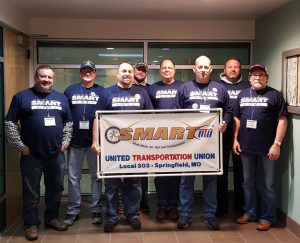
(Reprinted from SMART Local 104 Magazine)
On Saturday, March 3rd, SMART Sheet Metal Workers’ Local 104 members in Sacramento came out to support “the largest tax canvas in the history of the canvassing program.”
So what exactly does that mean, exactly?
It means members walked door to door with other Union members to help pass out information to underserved communities on where they could receive free tax preparation services through the non-profit United Way.
In total SMART members visited over 6,500 homes, which clearly shows just how heavy an impact our Unions can have when we come together and help. As Sacramento Business Representative Randy Young puts it, “We had 28 Local 104 members come out on a Saturday to help with this Campaign for Jobs action. One of the coolest aspects of it was that we actually had more Journeypersons than Apprentices, which shows our Union membership cares about making sure we are giving back to the community.
As Young concluded, “empowering our communities through service is one of our strongest assets.”
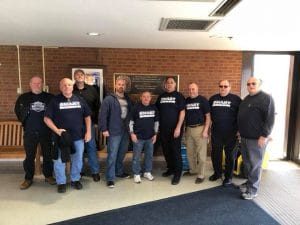 The SMART Local 73 SMART Army was out at the historic Hines VA Hospital spending some time with our veterans this past weekend. In this photo, from left to right are: Mike Roche, Mike Keeley, Organizer & Veterans Affairs director Eric Olson, Nick Fricano, Helmet Zieglur, President/Business Manager Rocco Terranova, Jimmy Dongarra, Dennis Liff , Steve Ziroli. Organizer Dave Sylvester took the picture.
The SMART Local 73 SMART Army was out at the historic Hines VA Hospital spending some time with our veterans this past weekend. In this photo, from left to right are: Mike Roche, Mike Keeley, Organizer & Veterans Affairs director Eric Olson, Nick Fricano, Helmet Zieglur, President/Business Manager Rocco Terranova, Jimmy Dongarra, Dennis Liff , Steve Ziroli. Organizer Dave Sylvester took the picture.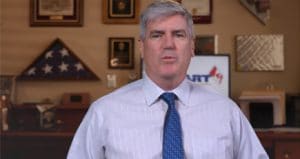
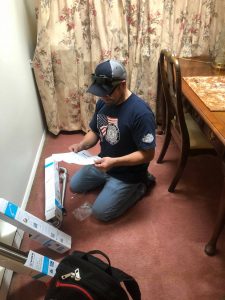
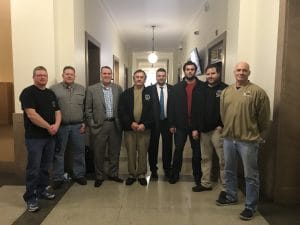
With a Democratic controlled House and Senate this was still no easy task as the slow and complicated legislative process worked itself out, yet, after two years HVAC licensing was enacted.
Fast forward to a 2016 red wave that ensured Republicans were in charge after 80 years of being out of power in West Virginia. Their first two pieces of legislation were Senate Bills #1 and #2 to repeal the prevailing wage and introduce tight to work – showing where their priorities lay.
They followed up this activity by attacking every facet of organized labor, some of their efforts were successful some were not but there was no mistaking who they were after. Each year after their takeover an individual member of The House of Delegates, who owns a nonunion HVAC company , put bills forward to repeal the HVAC licensing.
Ethics violations were filed against this delegate for acting solely in his self interest and Local 33 lobbied heavily. Several pro-labor Republicans joined Democrats in seeing these bills died in committee.
In early 2018, word was received that a bill was being introduced to repeal again. Partnership Development Rep and SMART lobbyist Steve Hancock was called upon to go to the Capitol and see what could be done to stop this legislation. Once there the picture became clear that this was not a normal repeal attempt as no longer were lower level members of the House of Representatives and Senators signed on to sponsor this bill. This time the Majority Leader of the House was sponsoring the House version and the Chairman of the Senate Workforce Committee was sponsoring the Senate version – showing it was now a high priority.
The lobbying on SMART’s behalf began in earnest. SMART Sheet Metal Local 24 Business Rep Jeff Rowe assisted along with Steve White (West Virginia Affiliated Construction Trades Foundation Director).
Thirty days into the session the legislation started to move and brother Hancock was approached to see if SMART would sit down and talk with a major lobbying firm that had an “unnamed client” as well as the Associated Builders and Contractors.
Steve Hancock and Steve White stayed in town over the weekend to meet with them and once at the table they were informed that the other side was concerned about defections from the GOP side to negotiate. In the end, the legislation was killed and GOP leaders vowed to not introduce it again as long as licensing requirements were lowered for residential technicians.
This came about due to the hard work and activism of SMART members and Local 33 – along with the solidarity shown from other trades and Local 24.
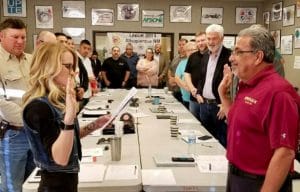
Brother Alvarado is the Business Manager and Financial Secretary for SMART Sheet Metal Workers’ Local 49, a position he has held since 2010. He is also a member of the Board of Trustees for the SMART Local 49 Health Plan and Joint Apprenticeship and Training Council. Alvarado is a third-generation sheet metal worker originally from El Paso, Texas and served in various leadership roles on the job and with his union for over two decades.
NMFL Secretary-Treasurer Ashley Long said, “The energy behind our Executive Board’s decision to appoint Vince as our new President was so enthusiastic and positive. There is a strong sense of unity that is growing and expanding across the New Mexico labor movement right now, and Vince is the exact leader we need.” Brother Alvarado, in accepting the appointment added, “The New Mexico labor movement has become more and more united ever since we joined together to defeat so-called right to work legislation four sessions ago, when we didn’t have the Governor or the House on our side. Our movement has been doing well, but there is always room for improvement. There was a lot of good energy when our Executive Board appointed me to lead the federation and there is a lot of potential to keep making our state better for working people.”
The Internal Revenue Service today released an updated Withholding Calculator on IRS.gov and a new version of Form W-4 to help taxpayers check their 2018 tax withholding following passage of the Tax Cuts and Jobs Act in December.
The IRS urges taxpayers to use these tools to make sure they have the right amount of tax taken out of their paychecks.
“Following the major changes in the tax law, the IRS encourages employees to check their paychecks to help ensure they’re having the right amount of tax withheld for their personal situation,” said Acting IRS Commissioner David Kautter.
The Tax Cuts and Jobs Act made changes to the tax law, including increasing the standard deduction, removing personal exemptions, increasing the child tax credit, limiting or discontinuing certain deductions and changing the tax rates and brackets.
If changes to withholding should be made, the Withholding Calculator gives employees the information they need to fill out a new Form W-4, Employee’s Withholding Allowance Certificate. Employees will submit the completed W-4 to their employer.
“Withholding issues can be complicated, and the calculator is designed to help employees make changes based on their personal financial situation,” Kautter said. “Taking a few minutes can help taxpayers ensure they don’t have too little – or too much – withheld from their paycheck.”
The withholding changes do not affect 2017 tax returns due this April. However, having a completed 2017 tax return can help taxpayers work with the Withholding Calculator to determine their proper withholding for 2018 and avoid issues when they file next year.
Steps to Help Taxpayers: Do a “Paycheck Checkup”
The IRS encourages employees to use the Withholding Calculator to perform a quick “paycheck checkup.” An employee checking their withholding can help protect against having too little tax withheld and facing an unexpected tax bill or penalty at tax time in 2019. It can also prevent employees from having too much tax withheld; with the average refund topping $2,800, some taxpayers might prefer to have less tax withheld up front and receive more in their paychecks.
The Withholding Calculator can be used by taxpayers who want to update their withholding in response to the new law or who start a new job or have other changes in their personal circumstances in 2018.
As a first step to reflect the tax law changes, the IRS released new withholding tables in January. These tables were designed to produce the correct amount of tax withholding — avoiding under- and over-withholding of tax — for those with simple tax situations. This means that people with simple situations might not need to make any changes. Simple situations include singles and married couples with only one job, who have no dependents, and who have not claimed itemized deductions, adjustments to income or tax credits.
People with more complicated financial situations might need to revise their W-4. With the new tax law changes, it’s especially important for these people to use the Withholding Calculator on IRS.gov to make sure they have the right amount of withholding.
Among the groups who should check their withholding are:
- Two-income families.
- People with two or more jobs at the same time or who only work for part of the year.
- People with children who claim credits such as the Child Tax Credit.
- People who itemized deductions in 2017.
- People with high incomes and more complex tax returns.
Taxpayers with more complex situations might need to use Publication 505, Tax Withholding and Estimated Tax, expected to be available on IRS.gov in early spring, instead of the Withholding Calculator. This includes those who owe self-employment tax, the alternative minimum tax, or tax on unearned income from dependents, and people who have capital gains and dividends.
Plan Ahead: Tips for Using the Withholding Calculator
The Withholding Calculator asks taxpayers to estimate their 2018 income and other items that affect their taxes, including the number of children claimed for the Child Tax Credit, Earned Income Tax Credit and other items.
Take a few minutes and plan ahead to make using the calculator on IRS.gov as easy as possible. Here are some tips:
- Gather your most recent pay stub from work. Check to make sure it reflects the amount of Federal income tax that you have had withheld so far in 2018.
- Have a completed copy of your 2017 (or possibly 2016) tax return handy. Information on that return can help you estimate income and other items for 2018. However, note that the new tax law made significant changes to itemized deductions.
- Keep in mind the Withholding Calculator results are only as accurate as the information entered. If your circumstances change during the year, come back to the calculator to make sure your withholding is still correct.
- The Withholding Calculator does not request personally-identifiable information such as name, Social Security number, address or bank account numbers. The IRS does not save or record the information entered on the calculator. As always, watch out for tax scams, especially via email or phone calls and be especially alert to cybercriminals impersonating the IRS. The IRS does not send emails related to the calculator or the information entered.
- Use the results from the Withholding Calculator to determine if you should complete a new Form W-4 and, if so, what information to put on a new Form W-4. There is no need to complete the worksheets that accompany Form W-4 if the calculator is used.
- As a general rule, the fewer withholding allowances you enter on the Form W-4 the higher your tax withholding will be. Entering “0” or “1” on line 5 of the W-4 means more tax will be withheld. Entering a bigger number means less tax withholding, resulting in a smaller tax refund or potentially a tax bill or penalty.
- If you complete a new Form W-4, you should submit it to your employer as soon as possible. With withholding occurring throughout the year, it’s better to take this step early on.
More information
This spring and throughout the year, the IRS will be working closely with businesses as well as the tax and payroll communities to help educate the public about the new withholding guidelines and the Withholding Calculator.
For 2019, the IRS plans to make further changes involving withholding. The agency will work with businesses and the tax and payroll communities to explain and implement these additional changes.
More information is available in the special Withholding Calculator Frequently Asked Questions.

For the fifteenth year in a row, Local 1 members were on hand to donate their time to make this event possible for local youth and their families.
Click here for more info about the event. https://www.ihsa.org/SportsActivities/MarchMadnessExperience.aspx